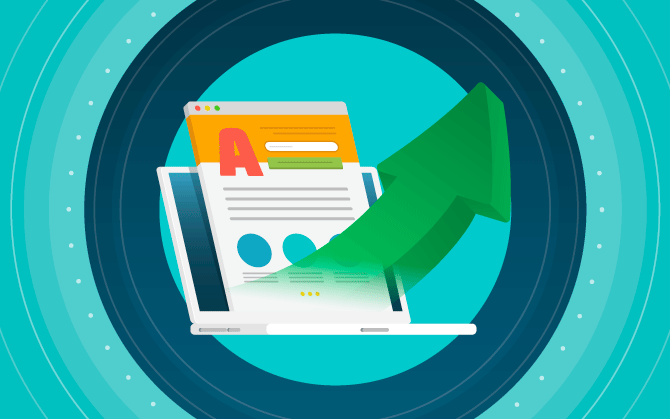
Crawl budget: why it is so important for your SEO efforts
Learn what a crawl budget is and how it can improve your website’s position on Google search results.

What will we see in this post
It’s estimated that more 160 billion searches are made every month, over 5 billion every day and over 60 thousand every second. That means that we can assume that more than 2 trillion searches are made per year worldwide.
This data is linked directly to Google, one of the main search engines nowadays.
Given the magnitude that it represents, the fact is that more businesses are increasingly investing in perfecting their online strategies. And the crawl budget is one of them.
However, what entrepreneurs need to understand is that the competition for reaching the coveted first-page ranking increases daily. That means you need to use more advanced strategies, such is the case of crawl budget.
In this post, we explain what crawl budget is, how it’s linked to a webpage reading time and other related issues. Keep reading and find out how this strategy can help you!
What is crawl budget?
Crawl budget is a tracking budget. But its meaning goes far beyond that.
Actually, it’s linked to the time that the Google bot takes to read or “scan” your website. After having defined how many and which pages are in fact important, according to the quality of the content posted.
The more quality pages it reads, the better your website will be qualified by the Google intelligence system.
It’s not possible to know exactly how long it takes Google to read your website, but we can have an idea through the Google Search Console.
Once you have the number of pages on your website, it’s possible to understand how it’s read by the search engine’s bot.
How does Google read webpages?
Before we explain how Google reads pages, it’s important to clarify a few relevant details.
Using the crawl budget is only worth it when your website has more than 10 thousand pages, i.e., large websites, such as e-commerce sites.
Otherwise, you don’t need to worry because a website with only a few pages won’t influence Google’s reading time.
However, there are a few aspects that will help you have more pages read, which is essential for any website. We’ll talk more about the tips to make this possible later. For now, we’ll focus on the reading issue.
Google takes some time before it connects to your website, reads the pages and only then stops reading. This process happens several times during the day. It’s precisely in that fraction of time in which it occurs that authority is achieved, which is crucial for positioning in search engines.
To make this even clearer, imagine that your website has several quality hyperlinks pointing to it.
Google will probably give it more prominence because this means you’re your website is a benchmark.
Thus, in order to optimize the reading time that the bot takes on your website, you need to focus on strategies.
Remember that by crawling only a certain number of pages on your website, Google might classify it incorrectly, i.e., different from what you expected.
This happens, for example, when your “About us” page (which does not generate sales) gains more visibility in searches than the page containing content to convert leads and products. Therefore, working with the crawl budget helps you to present Google with the content that has greater relevance and that has been updated.
How to improve Google’s reading time on your page
As we said earlier, there are efficient ways of improving your crawl budget strategy. Below, you’ll learn how it can be optimized!
Simplify your website’s architecture
When it comes to optimizing a page’s read time, one of the main tips is simplification. This means structuring your website layer by layer, starting with the information architecture and then moving on to the content, layout, programming, and hosting.
The page can be crawled if the search mechanisms can find it and follow the link to your website. If your goal is to make it highly-ranked, you also need to be careful when using valuable media features, such as JavaScript and Flash.
Moreover, if the person is redirected several times before they reach the destination page, this can also affect it. Therefore, keep a simpler structure so that you can optimize your website loading time.
Eliminate useless content
Useless content can and must be eliminated from your website. Maybe you have some articles with only a few accesses you haven’t updated?
Well, it interferes in the crawl budget and can be adverse for the search engines to find what is truly important.
Therefore, clean up all information that doesn’t add value to your website. If it’s important, you need to update it frequently. This is because Google understands and reads content that is constantly updated with higher frequency.
Identify pages with duplicated content
Certain websites have problems with content duplication. Sometimes, the same (or almost the same) content is available at different URLs.
In this case, you should update the information of a page complementing it with the information from the other page. This is important to prevent it from being seen as duplicate content.
If you have a blog with a lot of content, perhaps two texts with similar topics or practically the same keyword. You should pay attention when entering different URLs to avoid this.
Or, as we mentioned earlier, use the new text with a similar topic to complement the existing one.
Besides avoiding duplication, this will increase your content’s value even more and will make it gain more prominence on Google.
Apply SEO strategies
Applying an SEO strategy is crucial for crawl budget. Then, there’s a series of tips to be put into practice.
First and foremost, think about your content and keyword strategy. Search the most common terms sought by your audience on topics related to your business.
So, when it’s time to produce content, don’t forget your keywords while writing your text and to insert them in your internal title, intertitles and SEO components (SEO title, meta-description, slug, image alt-text).
As to the content, it needs to be truly relevant and scannable for your audience. In other words, material that adds value to those who searched for it is key. It needs to have not only relevant data, but also structural quality, such as short paragraphs, the use of intertitles, bullet points, and connectives.
It’s important to insert internal and external links that make sense in your text. But be careful with broken links, i.e., those that are linked to pages that no longer exist.
Why is it important to optimize crawl budget?
A well-structured website, with quality content and in conformity with the rules that Google’s bot sees as good practices, increases the crawl rate. This means that your position on the search engine results will improve. Consequently, the chances of your website being found by your audience also increases.
In addition, it will offer users a good overall experience.
Crawl budget is a complex issue, but extremely important, especially if your website includes hundreds of embedded pages.
Therefore, it’s always a good idea to keep your attention focused on optimizing what was specified here. Doing this will help you boost your website’s reading time, making it possible for you to reach the coveted first page on Google.
If you still have any questions about this subject or if you’d like to learn more about its application, leave us your comment!




